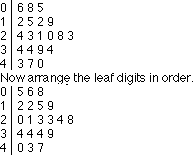 Stem and Leaf Graphs Stem and Leaf Graphs
A stem and leaf diagram or chart provides a means of sorting data into order.
Numbers are split into categories of the first digit(s) and the last digits(s)
e.g. Given the following 20 test scores:
06, 24, 43, 23, 12, 34, 21, 08, 15, 47,
40, 20, 12, 05, 19, 28, 34, 23, 39, 34
Let the stem be the first digit (the tens column). Now enter each of the second digits (the units column) into the leaf part of the diagram.

Using a stem and leaf graph the middle score, the median can be easily found.
There are 20 scores so the median is halfway between the 10th and the 11th scores.
So count in 10 scores from either the top or from the bottom of the stem and leaf graph. As the 10th score is 3 and the 11th score is 3, the median is also 3.
Tree Diagrams 
A tree diagram can help to solve probability problems or problems involving the number of ways that things can be carried out.
e.g. A family have three children. They could have had a girl followed by a boy followed by a girl.
How many different ways could the three children have arrived? (assume the chance of having a boy or a girl are equal.)
A tree diagram helps solve this problem.
As can be seen there are 8 possible combinations of children!
(This type of problem can be done using the multiplication principle: 2 ways × 2 ways × 2 ways = 8 ways)
|